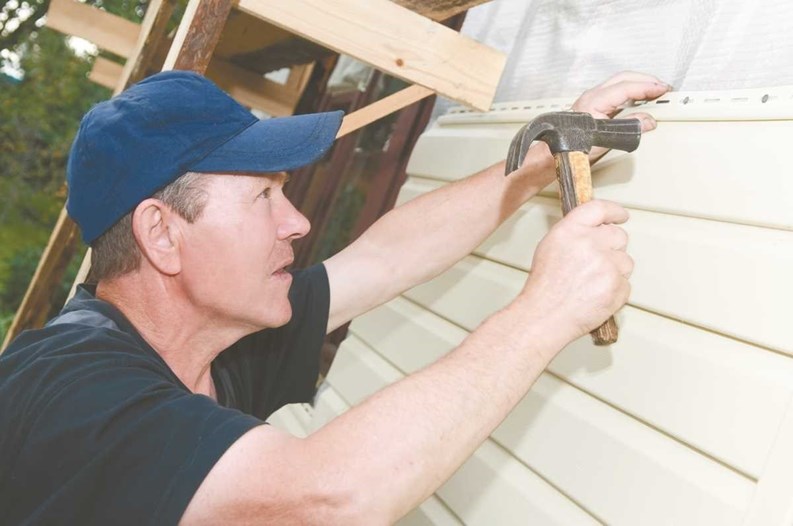As spring dawns anew on the frigid New England landscape, many condo dwellers will get their first prolonged looks at Mother Nature’s wintery ravages. Likely nowhere is this better seen than on a property’s exterior siding, much of which may need cleaning or replacement in the season ahead.
For those properties that do need large-scale siding replacements, experts say there are a few tips to remember for long-term siding success. “No matter which type of siding you choose, the primary thing you need to consider is what you put in there for a barrier,” explains Jack Carr, senior vice president of the Portland, Maine-based Criterium Engineers. A professional engineer and reserve specialist, Carr says the correct installation of a property’s building wrap—what Carr calls “building flashing”—is the most important aspect of any new siding job. “Every joint needs to be sealed with tape. It needs to be overlapped. It needs to be done properly around the corners.”
In addition to the all-important building wrap, thoughtful contractors will often recommend a global window replacement as a part of any major siding job. “It’s the rare property where we convince every homeowner it’s the right thing to do,” says Ralph Noblin, P.E., of Bridgewater, Massachusetts-based Noblin & Associates. “If you don’t replace the windows after 25 years because the homeowner screams that he doesn’t have the money, it’s gonna haunt you.”
Experts say a proper interface between newly installed windows and the building wrap will prove the most important aspect of any condo’s weather barrier. “If those things are done properly, no matter what siding they put on, the building will be tight,“ says Carr. “If the property manager or board were to insist on any one thing, they should insist that every important point of the barrier installation be checked off on some sort of checklist—that some supervisory level person, not the guy installing it, checks off every single joint.”
Options Abound
When it comes time to choose the actual siding materials, today’s condo boards have more options than ever—from vinyl to fiber cement to eco-friendly recycled clapboards, most of which are constructed from post-consumer wood products. Yet many top engineers are skeptical of such “green” innovations. “I think some of [those products] haven’t lasted very long,” says Carr. “If that recycled product only lasts five years, it wasn’t all that green.”
Even with the proliferation of new materials, most up-market condo properties still choose traditional wood clapboards for their new siding projects. And, despite the cost of constant upkeep, many unit owners continue to prefer wood’s timeless appeal.
“I’m still a wood guy,” says Noblin. “I like wood, but I acknowledge that, with the high cost of maintenance—those painting cycles—it’s difficult. The condo industry has suffered forever from the sheer size of the complexes. If I’m a condominium painting contractor, and I’ve got 200 units in Worcester or Framingham and another hundred units on Cape Cod, and they’ve all got to get painted, with the inclement weather we tend to have pretty regularly, they’re probably going to get painted when it’s too wet, too cold, too dirty, or all of the above. That’s why paint jobs, as expensive as they are, have very high failure rates.”
When it comes to wood clapboards, regularly scheduled painting cycles are the key to proper siding maintenance. “Properties that are on a consistent cycle, and don’t try to stretch the cycle, those properties will tend to stay with wood,” explains condo painting contractor Jack O’Donnell, owner of the Massachusetts-based Coatings Corp. “It’s the properties that try to go from five years to seven years that eventually have to play catch up. They’re always chasing repairs.”
With the ongoing cost of wood maintenance—and the rising cost of new building materials—many condo communities have begun to consider new options for their upcoming siding projects. One such option, fiber cement clapboards, may provide a suitable alternative for cost-conscious associations. But, the product is not without its drawbacks, says Noblin. “It’s a synthetic product that’s supposed to look like wood. I’m not sure I agree with that. And it’s supposed to last a wicked long time. I’m not sure I agree with that either.”
Sold under trade names like Hardieplank®, WeatherBoards and Maxitile®, fiber cement offers clapboard siding at prices up to 50 percent less than their wooden counterparts. With product guarantees ranging from 30 to 50 years, many managers see fiber cement siding as an obvious choice for long-term cost savings. “If a property is a clapboard property and they’re doing repairs, it’s definitely a less expensive route to go,” says O’Donnell.
Yet fiber cement is not without its detractors, and experts say strict adherence to guidelines is key to a successful install. “The problem with that stuff,” observes Carr, “is that it’s very susceptible to water damage.” It can be damaged on its end grain if it’s not properly sealed. It can be damaged if gets a lot of backsplash. It can even get damaged up near the soffits where vapor, coming out of a soffit vent, over time will affect it.”
“People said it was just as good as real wood,” recalls Noblin. “And it was a nightmare to the point that there were class action lawsuits nationwide. The manufacturers are, as we speak, getting more and more involved in litigation because the stuff just isn’t what it’s cracked up to be. It’s purports to be a 50-year product, and we’re seeing it fail in as little as five to six years.”
Class action suits are currently pending against several prominent fiber cement manufacturers, among them James Hardie—maker of the popular Hardieplank—and CertainTeed, with damage claims ranging from product shrinkage to cracking and warping. Some properties reported severe fiber cement siding shrinkage, leaving large gaps between individual clapboards.
“But you still have a lot of people who, if they hold a piece of fiber cement siding in their hands, which could weigh 10 pounds, and a piece of vinyl siding in their hands that is only one pound, they can convince themselves that the fiber cement siding clearly feels better,” says Noblin. “Well, feelings are for counseling sessions. That stuff, even though it feels heavy, really doesn’t last on the outside of a building. Vinyl is definitely superior in my mind.”
Vinyl Comes of Age
Introduced to American homeowners in the late 1950s, vinyl seemed a godsend to a post-war consumer culture built on the philosophy of newer, cleaner, and better living through science. Although colorfastness was problematic initially, the following decade brought considerable advances in vinyl technology. Soon there were vinyl products available in varying styles and thicknesses—some as thin as 35 millimeters—bringing a new façade within reach of any homeowner.
“Within the condo world,” says Noblin, “throughout the ’70s, ’80s and ’90s, vinyl siding was thought to be a cheap alternative that didn’t really look that much like wood.” Yet as vinyl’s appearance improved, the low-cost lure began to take hold. “If you talk to some of your property managers who handle the bigger properties, you’ll hear numbers for painting cycles reaching $2,000 to $3,000 a unit,” he says. Faced with regular painting bills totaling in the hundreds of thousands, many associations that once shunned vinyl have warmed to the maintenance-free option. “You’re painting wood six times. With vinyl, you might pressure wash it every now and then,” Noblin says.
“Vinyl is a good product,” says Carr, “but it’s not what every condominium wants its façade to look like. If I find a condominium that has had trouble in the past coming up with a good painting cycle, sometimes I do suggest a vinyl siding replacement. It’s fast, easy, and—if done properly—tends to be a pretty good product.”
“When somebody has to be forced to paint wood siding,” remarks O’Connell,” then it’s time to switch to vinyl, which is more maintenance-free.”
In the end, say the experts, there isn’t one “best” siding material, and there are no cookie-cutter solutions for new siding installations. “One of the first things you do when you take on a new condo association client is size them up to find out historically how this village has reacted to financial issues and decision-making,” Carr says. “If you sense these folks will not maintain the property the way you’d like them to, then you make recommendations for materials that are less sensitive to bad maintenance habits. So you custom fit it, in some ways, to what you think the association is able to handle.”
Matthew Worley is a freelance writer and a frequent contributor to New England Condominium.







Comments
Leave a Comment